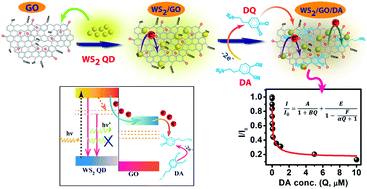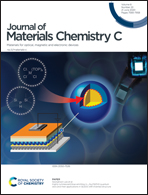Quantitative understanding of the ultra-sensitive and selective detection of dopamine using a graphene oxide/WS2 quantum dot hybrid†
Abstract
Herein, we have reported the ultra-high sensitive and selective detection of dopamine (DA) at the pico-molar level using a low cost sensing platform based on graphene oxide (GO) sheets anchored with tungsten disulfide quantum dots (WS2 QDs). The liquid phase exfoliated WS2 QDs are mostly bilayered with an average particle size of ∼2.0 ± 0.3 nm, while the GO sheets are of few-layer thickness. The WS2 QDs are highly luminescent with a photoluminescence (PL) quantum yield of ∼15%, and they exhibit an excitation wavelength dependent spectral shift in PL due to the high degree of edge/defect states. In the presence of GO, the PL intensity of WS2 QDs is partially quenched due to van der Waals interaction and excited-state charge transfer from WS2 to GO. However, in the presence of DA, a drastic quenching of PL occurs for the WS2/GO hybrid and this enables the selective detection of DA as low as 10 pM, which is the lowest among the reported values. We have presented a new model to quantitatively explain the GO mediated efficient charge transfer and unusual quenching of PL as a function of the DA concentration. Finally, the WS2/GO based sensor is utilized for the detection of DA in river water and blood serum with a satisfactory recovery, which establishes its practical utility as an efficient environmental/biochemical sensor.



 Please wait while we load your content...
Please wait while we load your content...